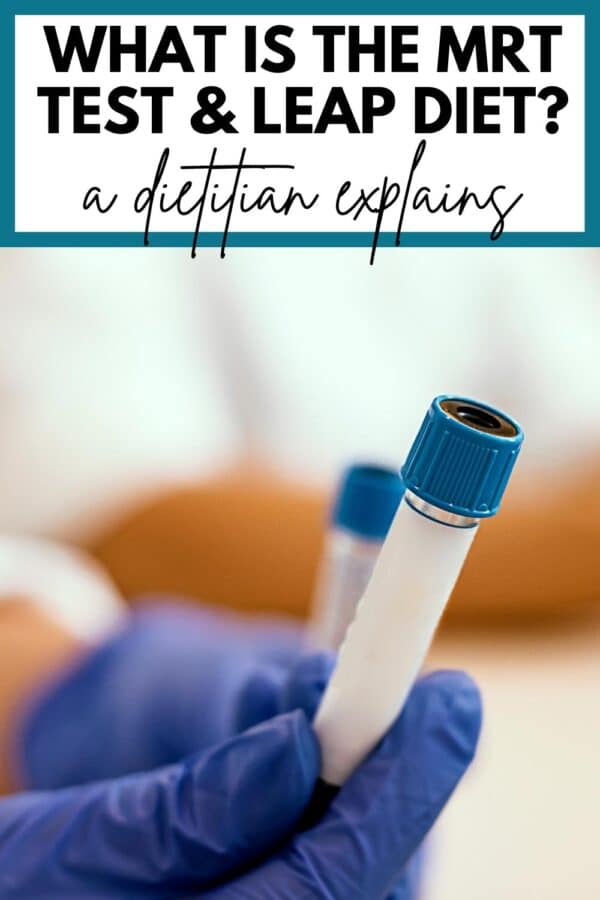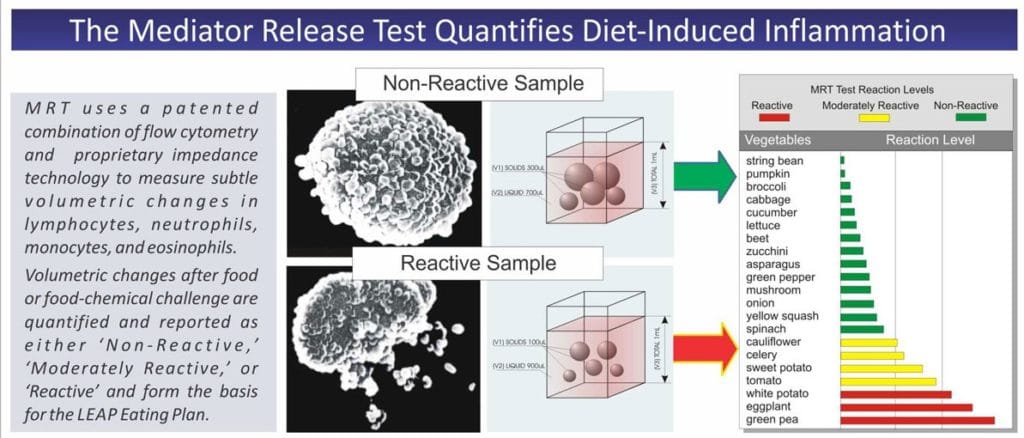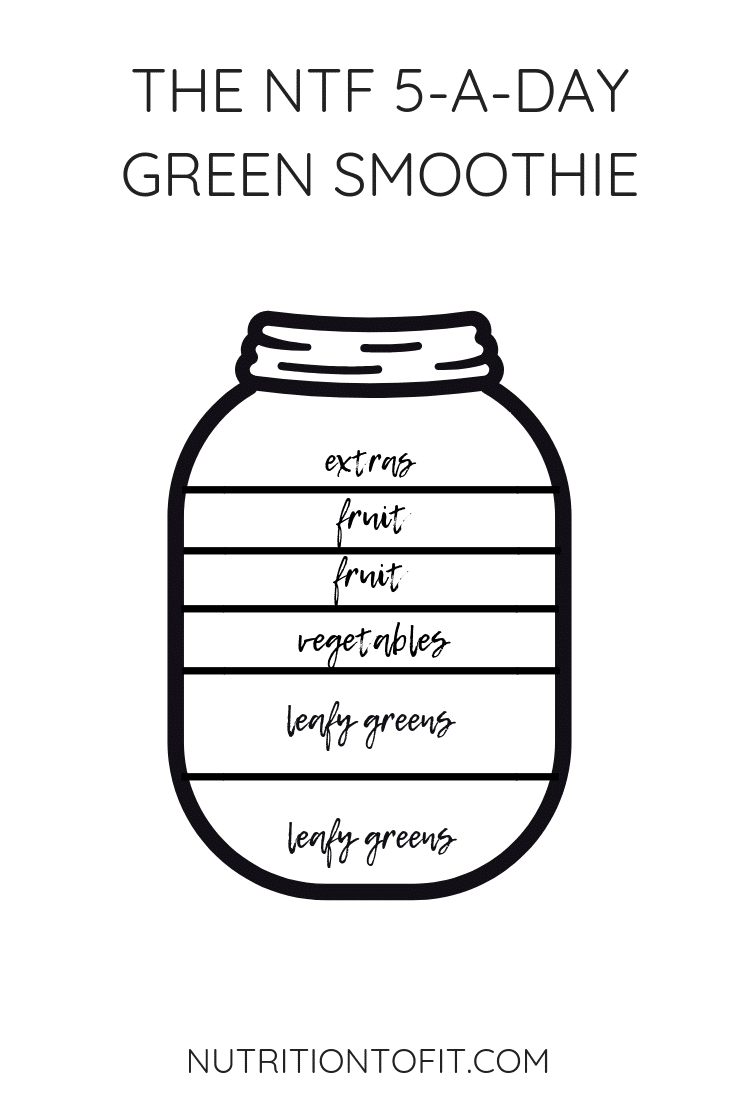What is the MRT Test and LEAP Diet?
If you’ve wondered if you have a food sensitivity you may have thought about taking a food sensitivity test – like the MRT test. But what is the MRT test? And what is the LEAP diet? Does MRT/ LEAP work? Or is it just another bogus food sensitivity test? I’m a registered dietitian who went through the certified LEAP therapist training and I’m here to tell you all about it.

What is the MRT Test?
MRT test stands for a mediator release test. The MRT food sensitivity test is a blood test that’s like a food inflammation test. It identifies foods and food chemicals or additives that are causing inflammatory reactions in the body.
The MRT test and associated LEAP diet protocol are patented by Oxford Biomedical Laboratories.
How Does the MRT Test Work?
The MRT test works by using a combination of flow cytometry and proprietary impedance technology. It measures subtle volume changes in mediators from white blood cells – lymphocytes, neutrophils, monocytes, and eosinophils.
These volumetric changes after food or food-chemical challenge are quantified and reported as either ‘Non-Reactive,’, ‘Moderately Reactive,’ or ‘Reactive’ and form the basis for the LEAP Eating Plan. At the time of this writing, MRT currently tests for 170 different foods and food chemicals.
What Do White Blood Cells Have to Do with Food Sensitivities?
Food sensitivities are quite complex and the gold standard approach is an elimination diet. Unfortunately many folks feel lost amongst all the many types of elimination diets that exist.
The MRT test and LEAP protocol aims to create an individualized elimination diet by looking at the proinflammatory and proalgesic mediator release from white blood cells.
The logic behind this is that mediators releasing create the negative side effects and symptoms of food sensitivities. Things like cytokines, histamine, leukotrines, prostaglandins, and more from white blood cells, like neutrophils, monocytes, eosinophils, and lymphocytes.
So is the MRT Test a Food Allergy Test?
No – MRT testing is not a food allergy test and will not show food allergies. Food allergies look at IgE reactions.
The MRT test looks at mediators released from white blood cells alone and is not, nor has it ever been marketed as a food allergy test.
I wanted to emphasize this, because there was a Practice Paper from the Academy of Nutrition and Dietetics speaking out against the use of MRT/ LEAP for food allergies, which MRT/ LEAP doesn’t actually do.
Food allergies and food intolerances and sensitivities are two separate things. If you suspect you have a food allergy, you need to see an allergist to get tested.
Is MRT Testing the Same as LEAP Testing?
They’re related, but no. LEAP testing isn’t actually a thing. MRT testing is what you do that allows you to do the LEAP protocol, or LEAP diet.
MRT Food – What Can You Eat?
The LEAP Eating Plan consists of eating only your MRT food for a brief time (typically 4-6 weeks). These allowed foods will vary for everyone, as they’re all based on your individual MRT results.
I’d like to note that the LEAP protocol does allow for flexibility for things like health conditions, religious backgrounds, cultures, cooking skills, etc.

LEAP Protocol – What to Expect on Your LEAP Diet
The LEAP protocol is designed to:
- Reduce the level of inflammation and related symptoms as quickly as possible.
- Through oral challenges, identify any additional contributors to symptoms not caused by delayed hypersensitivity reactions, in order to create a safe, customized diet.
- Identify client symptoms that need more rigorous follow-up or referral to another medical team member.
There are three phases of the LEAP diet protocol:
LEAP Diet Phase 1
The LEAP diet phase 1 is 10-14 days in duration. During this initial phase, you only consume tested, safe foods. The goal is to quickly reduce inflammation, achieve a noticeable reduction in symptoms and create a new baseline for later oral challenges.
LEAP Diet Phase 2
The LEAP diet phase 2 is 20-35 days long and is when you challenge with other tested foods. Any other immune and non-immune reactions that might be impacting the client’s health may be unmasked (i.e. fat malabsorption, IgE allergies, fructose intolerance, etc.). The goal is to identify more safe foods.
LEAP Diet Phase 3
The LEAP diet phase 3 is 30-60+ days long, or as needed. The goal is to continue to expand and “normalize” the diet by continuing to challenge any remaining MRT-tested foods, untested foods, or both. As you move forward, the goal is more dietary variety to help provide a nutrient dense diet and a healthy microbiome.
Who is MRT Food Sensitivity Testing for?
MRT food sensitivity testing is intended to be for anyone that needs help managing a chronic inflammatory condition. Examples include IBS, PCOS, GERD, ulcerative colitis, chronic migraines (not related to menstrual cycles), eczema, and other conditions.
Who is the LEAP diet not for? Anyone that has an active eating disorder. If you currently have a history of an eating disorder or disordered eating, tread cautiously. The first phase of the LEAP protocol is very restrictive. While temporary, it could still be very triggering and damaging to your health.
MRT Blood Test: How to Get MRT Testing Done
To get an MRT blood test you need to connect with a Certified LEAP Therapist that you’ll be working with during all of the MRT testing and LEAP diet protocol. They will help arrange testing for you.
You can also reach out to Oxford Biomedical Technologies themselves about getting an MRT blood test.
The actual testing process is fairly painless: your CLT will help you find a designated lab where you’ll take the test kit and information your CLT has given or sent you. They draw your blood and then overnight your blood sample to the lab in Florida for analysis.
From there, results are sent to your CLT. They will create a LEAP protocol tailored to you and your specific results.
MRT Test Cost
The MRT test cost is expensive, to the tune of hundreds of U.S. dollars. But because the MRT test alone is pretty useless without the LEAP protocol and a dietitian to guide you through it, you’ll also need consultations with a certified LEAP therapist.
MRT testing is not covered by insurance. Some insurance networks also don’t cover the cost of nutrition consultations, or only cover a dietitian consultation when associated with limited health conditions. Unfortunately, this makes MRT/ LEAP cost-prohibitive for many.
That said, my network of LEAP nutritionists say that their clients are often able to successfully use their FSA/ HSA funds to cover the MRT test cost and dietitian services.
A number of certified LEAP therapists also try to absorb some of the costs to their clients by creating packages that bundle their services for the LEAP diet protocol with the MRT test.
All dietitians structure their practices and services differently, though, so if LEAP/MRT testing is something you’re interested in, you’ll need to find a LEAP therapist near you and inquire how they structure and price services
How to Find a LEAP Therapist
To find a certified LEAP therapist, try Google searching “certified LEAP therapist near me.” If you can’t find any results, try contacting Oxford Biomedical Technologies and ask if they can help connect you to a CLT.
Is the LEAP Diet Good for Weight Loss?
The LEAP diet is not a weight loss diet – it is not for you if you’re looking for an easy weight loss solution. Weight loss is not the goal with LEAP; improved health through decreased inflammation and associated symptoms is the goal.
That said, due to decreased inflammation and often improved healthy eating behaviors for many clients (i.e. less ultra processed foods), there can sometimes be a correlation between the LEAP diet and weight loss.

Is the MRT Test and Leap Diet Evidence-Based?
At the time of publishing this article, there are no published peer-reviewed studies on MRT or the LEAP protocol.
There are plenty of positive testimonials and anecdotal experiences, which yes – are a part of evidence-based practice. But there are no studies at this time.
I highly recommend checking out this comprehensive overview on food sensitivity testing, along with current evidence on LEAP and MRT from Functional Nutrition Answers.
Final, Candid Thoughts on LEAP/ MRT:
I know there are many who swear by what a powerful tool MRT/ LEAP is, folks who struggled with debilitating symptoms and feel that MRT/ LEAP transformed their lives. And that is absolutely valid!
But the bottom line is we need peer-reviewed research.
Is MRT/ LEAP harmful? Not likely, if the individual is an appropriate candidate and is screened to ensure no disordered eating or eating disorders.
But it is also costly and requires a significant investment of time, energy, and finances.
My hope is that you now feel better equipped to make your own informed decision. Be well!
Original post was published February 23, 2018. It has been re-written for clarity and updated information at the time of re-publishing on December 27, 2021.







